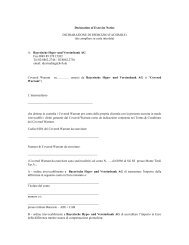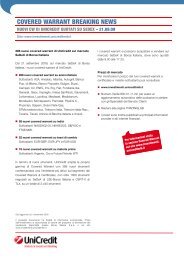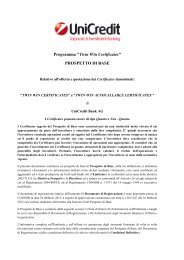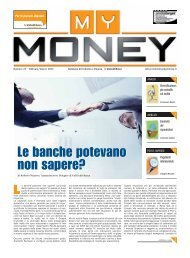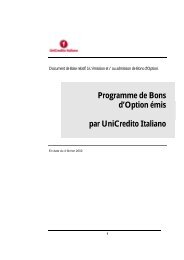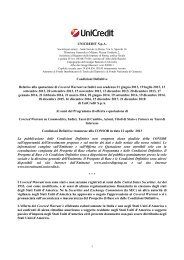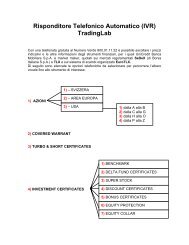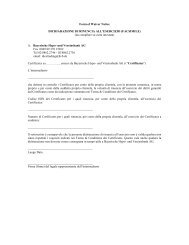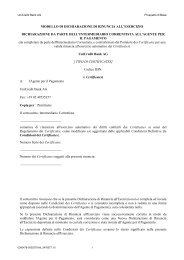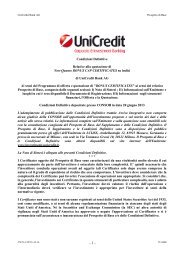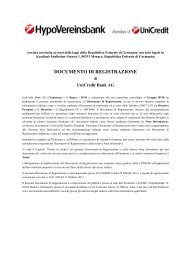UniCredit Bank AG
UniCredit Bank AG
UniCredit Bank AG
Create successful ePaper yourself
Turn your PDF publications into a flip-book with our unique Google optimized e-Paper software.
Financial Statements (2) | Consolidated Financial Statements<br />
Accounting and Valuation (CONTINUED)<br />
During subsequent measurement, both changes in the anticipated future cash flows and the time effect arising from a reduction of the discounting period<br />
are taken into account. The difference between the newly determined present value of the anticipated future cash flows at each balance sheet date and<br />
the carrying amount at the previous balance sheet date is recognised as a reversal of, or an addition to, allowances for losses on loans and receivables.<br />
In the case of loan receivables, the impairment determined in this way is posted to an impairment account which reduces the carrying amount of the<br />
receivable on the assets side. In the case of securities, an impairment directly reduces the carrying amount of the security.<br />
In the case of financial guarantees, a possible impairment is determined in the same way; the impairment loss is recognised as a provision.<br />
Specific loan-loss allowances or provisions to the amount of the anticipated loss have been made individually to cover all identifiable default risks arising<br />
from lending operations (loans, receivables and financial guarantees), with the amount of the expense being estimated. Specific loan-loss allowances are<br />
also determined on a collective basis for individual cases where the amounts involved are not significant. These allowances are recognised and disclosed<br />
within specific loan-loss allowances at HVB Group. Specific loan-loss allowances are reversed as soon as the reason for forming the allowance no longer<br />
exists, or used if the receivable is classified as uncollectable and written off. Acute country-specific transfer risks are included in this process.<br />
In the case of receivables (and guarantees) for which no specific allowances have been formed, portfolio allowances are set up to cover losses (= impairments)<br />
that have been incurred but not yet recognised by the <strong>Bank</strong> at the balance sheet date. We apply the loss confirmation period method for this. The<br />
loss confirmation period represents the period between a default event occurring or a borrower defaulting, and the point at which the <strong>Bank</strong> identifies the<br />
default. The loss confirmation period is determined separately for various credit portfolios on the basis of statistical surveys. The loss that has occurred<br />
but has not yet been recognised is estimated by means of the expected loss.<br />
In the case of assets classified as available for sale, a distinction is made between debt and equity instruments.<br />
A debt instrument is impaired when an event occurs that results in the borrower not being able to settle his obligations in full or at the agreed date.<br />
Essentially, an impairment exists in the same cases as for loan receivables from the same borrower (issuer).<br />
The amount of the impairment is defined as the difference between the amortised cost and the current fair value, whereby the difference first recognised<br />
in the AfS reserve in the balance sheet is taken to the income statement when an impairment occurs.<br />
Should the reason for the impairment no longer apply, the difference between the higher market value and the carrying amount at the previous balance<br />
sheet date is written back in the income statement up to the amount of initial cost. If the current market value at the balance sheet date exceeds the initial<br />
cost, the difference is recognised in the AfS reserve under shareholders’ equity.<br />
In the case of equity instruments carried at fair value, an impairment exists if the current fair value is significantly below the carrying amount or if the fair<br />
value has remained below the carrying amount for a prolonged period of time. Where this is the case, the difference between the current fair value and<br />
initial cost is recognised as profit or loss in the income statement. Such an impairment recognised in profit or loss has to be considered for the new<br />
cost basis required for the calculation of the AfS reserve. If the fair value rises in the future, the difference between a higher fair value and the initial cost<br />
adjusted as described is recognised in the AfS reserve under shareholders’ equity.<br />
Equity instruments valued at cost are considered impaired if the present value is significantly or permanently less than the acquisition cost (or, if an<br />
impairment has already been recognised in the past, it is less than the acquisition cost less the recognised impairment loss). If there is objective evidence<br />
of an impairment, the present value of the equity instruments must be determined. The estimated future cash flows discounted by the current market<br />
return on a comparable asset are used as the basis for determining this value. The amount of the impairment is calculated as the difference between the<br />
present carrying amount and the value of the equity instrument determined as described above. The impairment is taken to the income statement. An<br />
impairment of an equity instrument is not permitted to be reversed if the reasons for the impairment no longer apply.<br />
F-19<br />
106 2009 Annual Report · HypoVereinsbank




